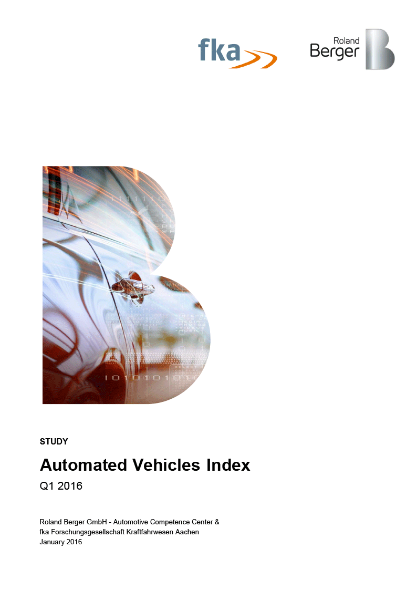Automated Vehicles Index Q1/2016
![{[downloads[language].preview]}](https://www.rolandberger.com/publications/publication_image/cover_automatedvehicles_download_preview.png)
The Index compares the relative competitive positions of the key markets Germany, France, Italy, the UK, Sweden, the US, Japan, China and South Korea.


Automated vehicles continue to be a hot topic in the international press – new innovations are in the pipeline and they are dominating the headlines. In collaboration with the Forschungsgesellschaft Kraftfahrwesen (fka), Roland Berger’s field experts combine industry and market indicators in the quarterly Automated Vehicles Index to map the current situation and provide a focus on relevant special topics. We analyze the competitive position of countries across the world—Germany, France, Italy, the UK, Sweden, the US, Japan, China, and South Korea—and report our insight into the automated driving topics that interest customers the most. The Q1 2016 issue takes a special look at competitive positioning, research and development in testing, legal frameworks, and global market volume.
The first quarter of 2016 sees little change to the top positions: Germany and the US continue to dominate, followed by Sweden, the UK, and Japan. Thanks to new models and close OEM collaboration with top universities and research centers, Germany is leading the way in industry with the US coming in a close second. Despite its lack of market share, however, Japan is entering the picture with the appearance of partially automated vehicles at the Tokyo Motor Show. The UK maintains a foothold partly thanks to generous subsidies for test facilities and pilot projects amounting to GBP 10 million.
A glance at legal frameworks also shows little change. Germany still lags behind the US, where simplified licensing procedures exist in some states. One of the biggest hurdles remains EU regulation ECE R79, which forbids automated steering functions above 10km/h, and the fact that the German government has yet to publish any concrete timeframe for the "Strategy for Automated and Connected Driving" (BMVi 2015).
Customer attitudes continue to be a decisive factor in global market volume and are positive. A 58% majority in the US and Germany and an overwhelming majority of 96% in China show interest in using AD in everyday situations, despite having never experienced the technology. However, interest levels in self-driving robot taxis drop considerably in all three countries to approximately half that of those showing support for everyday automated driving functions. These results show that the AV market will still have to face many market challenges, especially in the West.

![{[downloads[language].preview]}](https://www.rolandberger.com/publications/publication_image/cover_automatedvehicles_download_preview.png)
The Index compares the relative competitive positions of the key markets Germany, France, Italy, the UK, Sweden, the US, Japan, China and South Korea.

